Two Severe Prolonged Hydrological Droughts Analysis over Mainland Australia Using GRACE Satellite Data
Abstract
:1. Introduction
2. Materials and Methods
2.1. Data and Study Area
2.1.1. Data
GRACE Data
ENSO and IOD Indices
2.1.2. Study Area
2.2. Methods
2.3. Drought Conditions over Mainland Australia
3. Results
3.1. Drought Affected Area
3.2. Drought Spatial Evolution
3.3. Frequency of Different Drought Grades
3.4. Drought Severity
3.5. Relationships between the Two Hydrological Droughts and Indo-Pacific Climate Variability
4. Discussion
4.1. RMS of the Hydrological Drought Analysis
4.2. Comparison of Drought 2006–2009 and Drought 2018–2020
5. Conclusions
Author Contributions
Funding
Acknowledgments
Conflicts of Interest
References
- Rashid, M.M.; Simon Beecham, S. Characterization of meteorological droughts across South Australia. Meteorol. Appl. 2019, 26, 556–568. [Google Scholar] [CrossRef] [Green Version]
- Alkaisi, M.M.; Elmore, R.W.; Guzman, J.G.; Hanna, H.M.; Hart, C.E.; Helmers, M.J.; Hodgson, E.W.; Lenssen, A.W.; Mallarino, A.P.; Robertson, A.E.; et al. Drought impact on crop production and the soil environment: 2012 experiences from lowa. Soil Water Conserv. 2013, 68, 19A–24A. [Google Scholar] [CrossRef] [Green Version]
- Frank, A.; Armenski, T.; Gocic, M.; Popov, S.; Popovic, L.; Trajkovic, S. Influence of mathematical and physical background of drought indices on their complementarity and drought recognition ability. Atmos. Res. 2017, 194, 268–280. [Google Scholar] [CrossRef]
- Mo, K.C. Drought onset and recovery over the United States. J. Geophys. Res. Atmos. 2011, 116, 1–14. [Google Scholar] [CrossRef]
- Vu, M.T.; Vo, N.D.; Gourbesville, P.; Raghavan, S.V.; Liang, S.-Y. Hydro-meteorological drought assessment under climate change impact over the Vu Gia-Thu Bon river basin, Vietnam. Hydrol. Sci. J. 2017, 62, 1654–1668. [Google Scholar] [CrossRef]
- Spinoni, J.; Barbosaa, P.; Jagera, A.D.; McCormicka, N.; Naumanna, G.; Vogta, J.V.; Magnib, D.; Masanteb, D.; Mazzeschic, M. A new global database of meteorological drought events from 1951 to 2016. J. Hydrol. Reg. Stud. 2019, 22, 100593. [Google Scholar] [CrossRef]
- Leblanc, M.; Tweed, S.; Dijk, A.V.; Timbal, B. A review of historic and future hydrological changes in the Murray-Darling Basin. Glob. Planet. Chang. 2012, 80–81, 226–246. [Google Scholar] [CrossRef]
- Van Dijk, A.I.J.M.; Beck, H.E.; Crosbie, R.S.; de Jeu, R.A.M.; Liu, Y.Y.; Podger, G.M.; Timbal, B.; Viney, N.R. The Millennium Drought in southeast Australia (2001–2009): Natural and human causes and implications for water resources, ecosystems, economy, and society. Water Resour. Res. 2013, 49, 1040–1057. [Google Scholar] [CrossRef]
- Kauwe, M.G.D.; Medlyn, B.E.; Ukkola, A.M.; Mu, M.; Sabot, M.E.B.; Pitman, A.J. Identifying areas at risk of drought-induced tree mortality across South-Eastern Australia. Glob. Chang. Biol. 2020, 26, 5716–5733. [Google Scholar] [CrossRef]
- Creutzfeldt, B.; Ferré, T.; Troch, P.; Merz, B.; Wziontek, H.; Güntner, A. Total water storage dynamics in response to climate variability and extremes: Inference from long-term terrestrial gravity measurement. J. Geophys. Res. Atmos. 2012, 117, D08112. [Google Scholar] [CrossRef] [Green Version]
- Thomas, A.C.; Reager, J.T.; Famiglietti, J.S.; Rodell, M. A GRACE-based water storage deficit approach for hydrological drought characterization. Geophys. Res. Lett. 2014, 41, 1537–1545. [Google Scholar] [CrossRef] [Green Version]
- Wahr, J.; Swenson, S.; Zlotnicki, V.; Velicogna, I. Time-Variable gravity from GRACE: First Results. Geophys. Res. Lett. 2004, 31, L11501. [Google Scholar] [CrossRef] [Green Version]
- Chen, J.L.; Wilson, C.R.; Tapley, B.D.; Scanlon, B.; Güntner, A. Long-term groundwater storage change in Victoria, Australia from satellite gravity and in situ observations. Glob. Planet. Chang. 2016, 139, 56–65. [Google Scholar] [CrossRef] [Green Version]
- Wang, S.S. Freezing temperature controls winter water discharge for cold region watershed. Water Resour. Res. 2019, 55, 479–493. [Google Scholar] [CrossRef] [Green Version]
- Doumbia, C.; Castellazzi, P.; Rousseau, A.N.; Amaya, M. High Resolution Mapping of Ice Mass Loss in the Gulf of Alaska From Constrained Forward Modeling of GRACE Data. Front. Earth Sci. 2020, 7, 360. [Google Scholar] [CrossRef]
- Zhang, L.S.; Zhu, X.F.; Pan, Y.Z.; Zhang, J.S. Assessing Terrestrial Water Storage and Flood Potential Using GRACE Data in the Yangtze River Basin, China. Remote Sens. 2017, 9, 1011. [Google Scholar]
- Cao, Y.P.; Nan, Z.T.; Cheng, G.D. GRACE Gravity Satellite Observations of Terrestrial Water Storage Changes for Drought Characterization in the Aid Land of Northwestern China. Remote Sens. 2015, 7, 1021–1047. [Google Scholar] [CrossRef] [Green Version]
- Sun, Z.L.; Zhu, X.F.; Pan, Y.Z.; Zhang, J.S.; Liu, X.F. Drought evaluation using the GRACE terrestrial water storage deficit over the Yangtze River Basin, China. Sci. Total Environ. 2018, 634, 727–738. [Google Scholar] [CrossRef]
- Liu, X.F.; Feng, X.M.; Ciais, P.; Fu, B.J.; Hu, B.Y.; Sun, Z.L. GRACE satellite-based drought index indicating increased impact of drought over major basins in China during 2002–2007. Agric. For. Meteorol. 2020, 291, 108057. [Google Scholar] [CrossRef]
- Sinha, D.; Syed, T.H.; Famiglietti, J.S.; Reager, J.T.; Thomas, R.C. Characterizing drought in India using GRACE observations of terrestrial water storage deficit. J. Hydrometeorol. 2017, 18, 381–396. [Google Scholar] [CrossRef]
- Sinha, D.; Syed, T.H.; Reager, J.T. Utilizing combined deviations of precipitation and GRACE-based terrestrial water storage as a metric for drought characterization: A case study over major Indian river basins. J. Hydrol. 2019, 572, 294–307. [Google Scholar] [CrossRef]
- Yu, W.J.; Li, Y.Z.; Cao, Y.P.; Schillerberg, T. Drought Assessment using GRACE Terrestrial Water Storage Deficit in Mongolia from 2002 to 2017. Water 2019, 11, 1301. [Google Scholar] [CrossRef] [Green Version]
- Jing, W.L.; Zhao, X.D.; Yao, L.; Jiang, H.; Xu, J.H.; Yang, J.; Li, Y. Variations in terrestrial water storage in the Lancang-Mekong river basin from GRACE solutions and land surface model. J. Hydrol. 2020, 580, 124258. [Google Scholar] [CrossRef]
- Chaudhari, S.; Pokhrel, Y.; Moran, E.; Miguez-Macho, G. Multi-decadal hydrologic change and variability in the Amazon River basin: Understanding terrestrial water storage variations and drought characteristics. Hydrol. Earth Syst. Sci. 2019, 23, 2841–2862. [Google Scholar] [CrossRef] [Green Version]
- Hosseini-Moghari, S.-M.; Araghinejad, S.; Ebrahimi, K.; Tourian, M.J. Introducing modified total storage deficit index (MTSDI) for drought monitoring using GRACE observations. Ecol. Indic. 2019, 101, 465–475. [Google Scholar] [CrossRef]
- Forootan, E.; Khandu Awange, J.L.; Schumacher, M.; Anyah, R.; van Dijk, A.I.J.M.; Kusche, J. Quantifying the impacts of ENSO and IOD on rain gauge and remotely sensed precipitation products over Australia. Remote Sens. Environ. 2016, 172, 50–66. [Google Scholar] [CrossRef] [Green Version]
- Forootan, E.; Khaki, M.; Schumacher, M.; Wulfmeyer, V.; Mehrnegar, N.; van Dijk, A.I.J.M.; Brocca, L.; Farzaneh, S.; Akinluyi, F.; Ramillien, G.; et al. Understanding the global hydrological droughts of 2003–2016 and their relationships with teleconnections. Sci. Total Environ. 2019, 650, 2587–2604. [Google Scholar] [CrossRef] [Green Version]
- Allen, K.J.; Freund, M.B.; Palmer, J.G.; Williams, L.; Brookhouse, M.; Cook, R.E.; Stewart, S.; Backer, P.J. Hydroclimate extremes in a north Australian drought reconstruction asymmetrically linked with Central Pacific Sea surface temperatures. Glob. Planet. Change 2020, 195, 103329. [Google Scholar] [CrossRef]
- Ummenhofer, C.C.; England, M.H.; McIntosh, M.C.; Meyers, G.A.; Pook, M.J.; Risbey, J.S.; Gupta, A.S.; Taschetto, A.S. What causes southeast Australia’s worst droughts? Geophys. Res. Lett. 2009, 36, L04706. [Google Scholar] [CrossRef] [Green Version]
- Cai, W.J.; Cowan, T. Dynamics of late autumn rainfall reduction over southeastern Australia. Geophys. Res. Lett. 2008, 35, L09708. [Google Scholar] [CrossRef]
- Cai, W.J.; Cowan, T.; Raupach, M. Positive Indian Ocean Dipole events precondition southeast Australia bushfires. Geophys. Res. Lett. 2009, 36, L19710. [Google Scholar] [CrossRef]
- Saji, N.H.; Goswami, B.N.; Vinayachandran, P.N.; Yamagata, T. A dipole mode in the tropical Indian Ocean. Nature 1999, 401, 360–363. [Google Scholar] [CrossRef] [PubMed]
- Risbey, J.S.; Pook, M.J.; Mcintosh, P.C. On the Remote Drivers of Rainfall Variability in Australia. Bull. Am. Meteorol. Soc. 2009, 137, 3233–3253. [Google Scholar] [CrossRef]
- Hu, T.; van Dijk, A.I.J.M.; Renzullo, L.J.; Xu, Z.H.; He, J.; Tian, S.; Zhou, J.; Li, H. On agricultural drought monitoring in Australia using Himawari-8 geostationary thermal infrared observations. Int. J. Appl. Earth Obs. 2020, 91, 102153. [Google Scholar] [CrossRef]
- Yang, Y.; Long, D.; Guan, H.; Scanlon, B.R.; Simmons, C.T.; Jiang, L.; Xu, X. GRACE satellite observed hydrological controls on interannual and seasonal variability in surface greenness over mainland Australia. J. Geophys. Res. Biogeosci. 2014, 119, 2245–2260. [Google Scholar] [CrossRef]
- Chen, T.; de Jeu, R.A.M.; Liu, Y.Y.; van der Werf, G.R.; Dolman, A.J. Using satellite based soil moisture to quantify the water driven variability in NDVI: A case study over mainland Australia. Remote Sens. Environ. 2014, 140, 330–338. [Google Scholar] [CrossRef]
- Leblanc, M.J.; Tregoning, P.; Ramillien, G.; Tweed, S.O.; Fakes, A. Basin-scale, integrated observations of the early 21st century multiyear drought in southeast Australia. Water Resour. Res. 2009, 45, W04408. [Google Scholar] [CrossRef]
- Köppen, W. Die Wärmezonen der Erde, nach der Dauer der Heissen, Gemässigten, und Kalten Zeit, und nach der Wirkung der Wärme auf die Organisch Welt betrachtet. Meteorol. Z. 1884, 1, 215–226. Available online: http://www.metvis.com.au/acc/index.html (accessed on 22 February 2021).
- Feng, T.; Wu, J.J.; Liu, L.Z.; Leng, S.; Yang, J.H.; Zhao, W.H.; Shen, Q. Exceptional Drought across Southeastern Australia Caused by Extreme Lack of Precipitation and Its Impacts on NDVI and SIF in 2018. Remote Sens. 2020, 12, 54. [Google Scholar]
- Mohamad, N.; Md Din, A.H. Monitoring Groundwater Depletion Due to Drought using Satellite Gravimetry: A Review. IOP Conf. Ser. Earth Environ. Sci. 2020, 540, 012054. [Google Scholar] [CrossRef]
- Tapley, B.D.; Bettadpur, S.; Ries, J.C.; Thompson, P.F.; Watkins, M.M. GRACE Measurements of Mass Variability in the Earth System. Science 2004, 305, 503–505. [Google Scholar] [CrossRef] [Green Version]
- Verdon-Kidd, D.C.; Kiem, A.S. Nature and causes of protracted droughts in southeast Australia: Comparison between the Federation, WWII, and Big Dry droughts. Geophys. Res. Lett. 2009, 36, L22707. [Google Scholar] [CrossRef]
- Dikshit, A.; Pradhan, B.; M. Alamr, A. Short-Term Spatio-Temporal Drought Forecasting Using Random Forests Model at New South Wales, Australia. Appl. Sci. 2020, 10, 4254. [Google Scholar] [CrossRef]
- Shi, L.J.; Feng, P.Y.; Wang, B.; Liu, D.L.; Yu, Q. Quantifying future drought change and associated uncertainty in southeastern Australia with multiple potential evapotranspiration models. J. Hydrol. 2020, 590, 125394. [Google Scholar] [CrossRef]
- Rahmat, S.N.; Jayasuriya, N.; Bhuiyan, M. Assessing droughts using meteorological drought indices in Victoria, Australia. Hydrol. Res. 2015, 46, 463–476. [Google Scholar] [CrossRef]
- Zhao, M.; Geruo, A.; Velicogna, I.; Kimball, J.S. A Global Gridded Dataset of GRACE Drought Severity Index for 2002–14: Comparison with PDSI and SPEI and a Case Study of the Australia Millennium Drought. J. Hydrometeorol. 2017, 18, 2117–2129. [Google Scholar] [CrossRef] [Green Version]
- Save, H.; Bettadpur, S.; Tapley, B.D. High-resolution CSR GRACE RL05 mascons. J. Geophys. Res. Solid Earth 2016, 121, 7547–7569. [Google Scholar] [CrossRef]
- Save, H. CSR GRACE and GRACE-FO RL06 Mascon Solutions v02. 2020. Available online: http://www2.csr.utexas.edu/grace/RL06_mascons.html (accessed on 22 February 2021). [CrossRef]
- Rangelova, E.; van der Wal, W.; Sideris, M.G.; Wu, P.B. Gravity, Geoid and Earth Observation; International Association of Geodesy Symposia; Springer: Berlin/Heidelberg, Germany, 2010; pp. 539–546. [Google Scholar]
- Watkins, M.M.; Wiese, D.N.; Yuan, D.-N.; Boening, C.; Landerer, F.W. Improved methods for observing Earth’s time variable mass distribution with GRACE using spherical cap mascons. J. Geophys. Res. Solid Earth 2015, 120, 2648–2671. [Google Scholar] [CrossRef]
- Solander, K.C.; Reager, J.T.; Wada, Y.; Famiglietti, J.S.; Middleton, R.S. GRACE satellite observations reveal the severity of recent water overconsumption in the United States. Sci. Rep. 2017, 7, 8723. [Google Scholar] [CrossRef] [PubMed] [Green Version]
- Cai, W.J.; van Rensch, P.; Cowan, T.; Hendon, H.H. An asymmetry in the IOD and ENSO teleconnection pathway and its impact on Australian climate. J. Clim. 2012, 25, 6318–6329. [Google Scholar] [CrossRef]
- Trenberth, K.E. Recent observed interdecadal climate changes in the Northern Hemisphere. Bull. Am. Meteorol. Soc. 1990, 71, 988–993. [Google Scholar] [CrossRef] [Green Version]
- Kim, T.W.; Valdes, J.B.; Nijssen, B.; Roncayolo, D. Quantification of linkages between large-scale climatic patterns and precipitation in the Colorado River Basin. J. Hydrol. 2006, 321, 173–186. [Google Scholar] [CrossRef]
- Saji, N.H.; Yamagata, T. Possible impacts of Indian Ocean dipole mode events on global climate. Clim. Res. 2003, 25, 151–169. [Google Scholar] [CrossRef]
- Rayner, N.A.; Parker, D.E.; Horton, E.B.; Folland, C.K.; Alexander, L.V.; Rowell, D.P.; Kent, E.C.; Kaplan, A. Global analyses of sea surface temperature, sea ice, and night marine air temperature since the late nineteenth century. J. Geophys. Res. 2003, 108, 4407. [Google Scholar] [CrossRef]
- Allan, R.J.; Nicholls, N.; Jones, P.D.; Butterworth, I.J. A further extension of the Tahiti-Darwin SOI, early SOI results and Darwin pressure. J. Clim. 1991, 4, 743–749. [Google Scholar] [CrossRef]
- Können, G.P.; Jones, P.D.; Kaltofen, M.H.; Allan, R.J. Pre-1866 extensions of the Southern Oscillation Index using early Indonesian and Tahitian meteorological readings. J. Clim. 1998, 11, 2325–2339. [Google Scholar] [CrossRef]
- Ropelewski, C.F.; Jones, P.D. An extension of the Tahiti-Darwin Southern Oscillation Index. Mon. Weather Rev. 1987, 115, 2161–2165. [Google Scholar] [CrossRef] [Green Version]
- Herring, S.C.; Christidis, N.; Hoell, A.; Kossin, J.P.; Schreck III, C.J.; Stott, P.A. Explaining extreme events of 2016 from a climate perspective. Bull.Am. Meteorol. Soc. 2018, 99, S1–S157. [Google Scholar] [CrossRef] [Green Version]
- Wanders, N.; Van Lanen, H.A.J.; van Loon, A.F. Indicators for Drought Characterization on Global Scale; Technical Report No. 24. 2010. Available online: https://library.wur.nl/WebQuery/wurpubs/fulltext/160049 (accessed on 22 February 2021).
- Nicholls, N. Sea surface temperature and Australian winter rainfall. J. Clim. 1989, 2, 965–973. [Google Scholar] [CrossRef] [Green Version]
- Knapp, C.H.; Carter, G.C.E.F. The Generalized Correlation Method for Estimation of Time Delay. IEEE Trans. Acoust. Speech Signal Process. 1976, 24, 320–327. [Google Scholar] [CrossRef] [Green Version]
- Rieser, D.; Kuhn, M.; Pail, R.; Anjasmara, I.M.; Awange, J. Relation between GRACE-derived surface mass variations and precipitation over Australia. Aust. J. Earth Sci. 2010, 57, 887–900. [Google Scholar] [CrossRef]
- Cleveland, R.B.; Cleveland, W.S.; Terpenning, I. STL: A seasonal-trend decomposition procedure based on loess. J. Off. Stat. 1990, 6, 3–73. [Google Scholar]
- Mishra, A.K.; Singh, V.P. A Review of drought concepts. J. Hydrol. 2010, 391, 202–216. [Google Scholar] [CrossRef]
- Schmidt, R.; Flechtner, F.; Meyer, F.; Neumayer, K.-H.; Dahle, C.H.; König, R.; Kusche, J. Hydrological Signals Observed by the GRACE Satellites. Surv. Geophys. 2008, 29, 319–334. [Google Scholar] [CrossRef]
- Wahr, J.; Swenson, S.; Velicogna, I. Accuracy of GRACE mass estimates. Geophys. Res. Lett. 2006, 33, L06401. [Google Scholar] [CrossRef] [Green Version]
- Forootan, E.; Kusche, J.; van Dijk, A.; Awange, J.L.; Schumacher, M.; Longuevergne, L. Non-stationary relationships between decadal water storage changes over Australia and climate variability of the El Niño Southern Oscillation and Indian Ocean Dipole. In Proceedings of the EGU General Assembly 2014, Vienna, Austria, 27 April–2 May 2014; Volume 16. EGU2014-4290. Available online: https://meetingorganizer.copernicus.org/EGU2014/EGU2014-4290.pdf (accessed on 22 February 2021).
- Anyah, R.O.; Forootan, E.; Awange, J.L.; Khaki, M. Understanding linkages between global climate indices and terrestrial water storage changes over Africa using GRACE products. Sci. Total Environ. 2018, 635, 1405–1416. [Google Scholar] [CrossRef] [PubMed] [Green Version]
- Lo, F.; Wheeler, M.; Meinke, H.; Donald, A. Probabilistic forecasts of the onset of the north Australian wet season. Mon. Wea. Rev. 2007, 135, 3506–3520. [Google Scholar] [CrossRef] [Green Version]

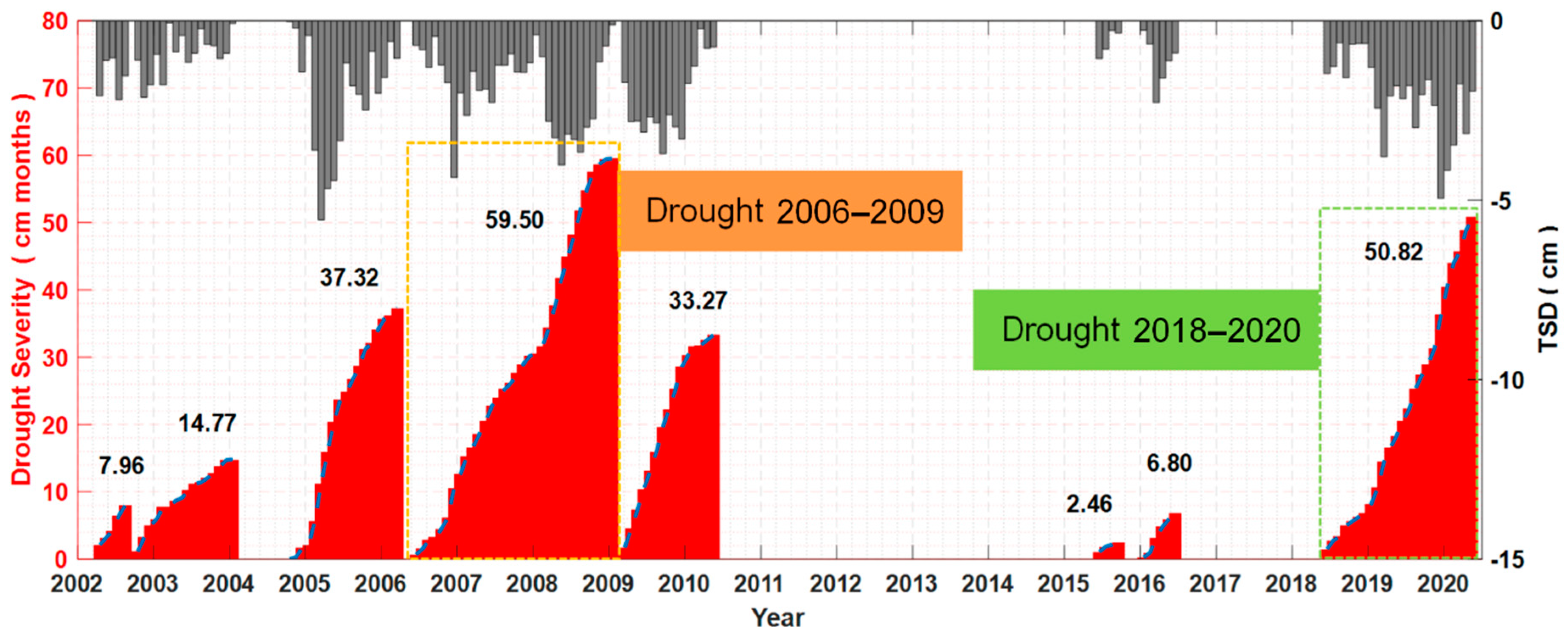

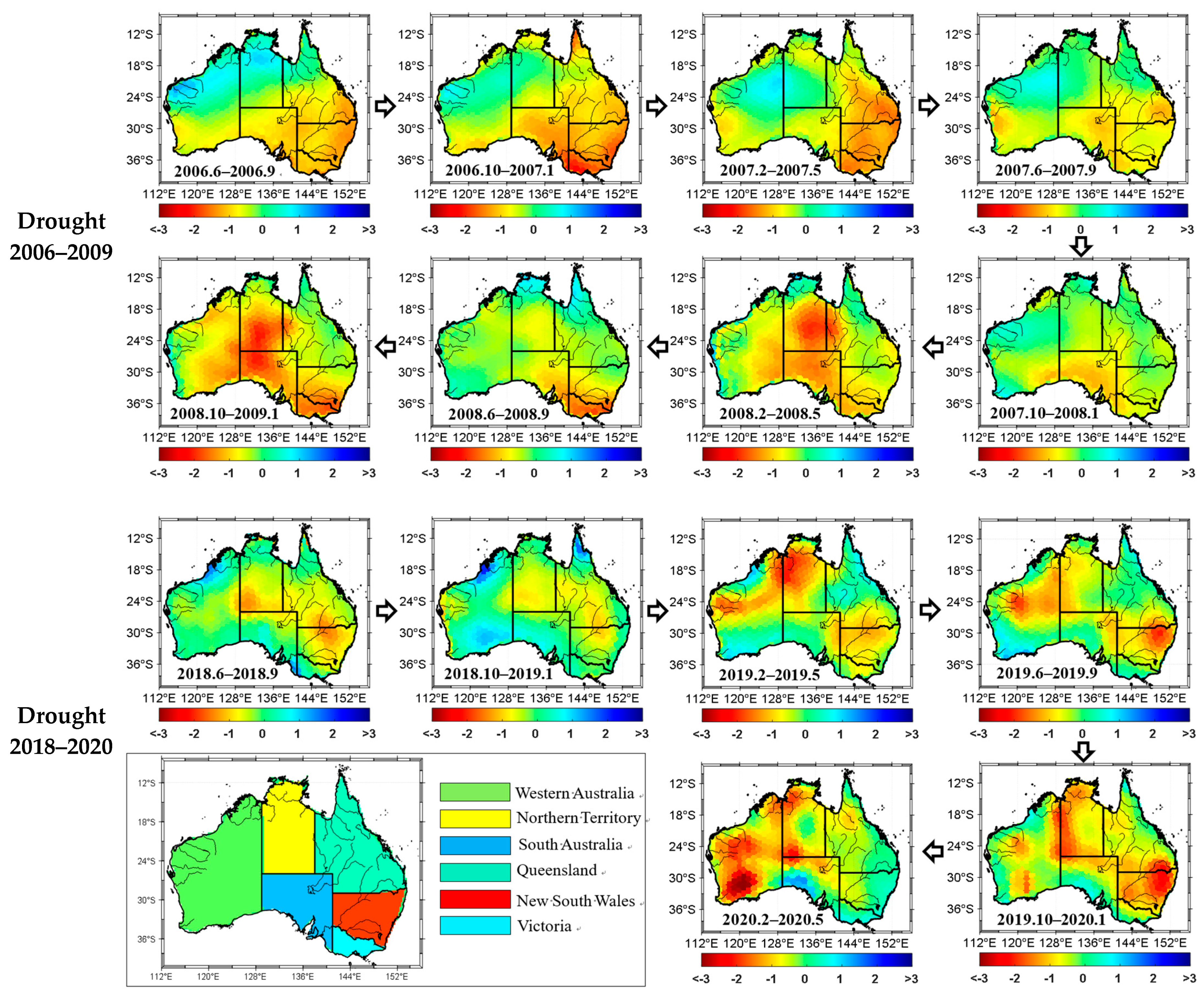

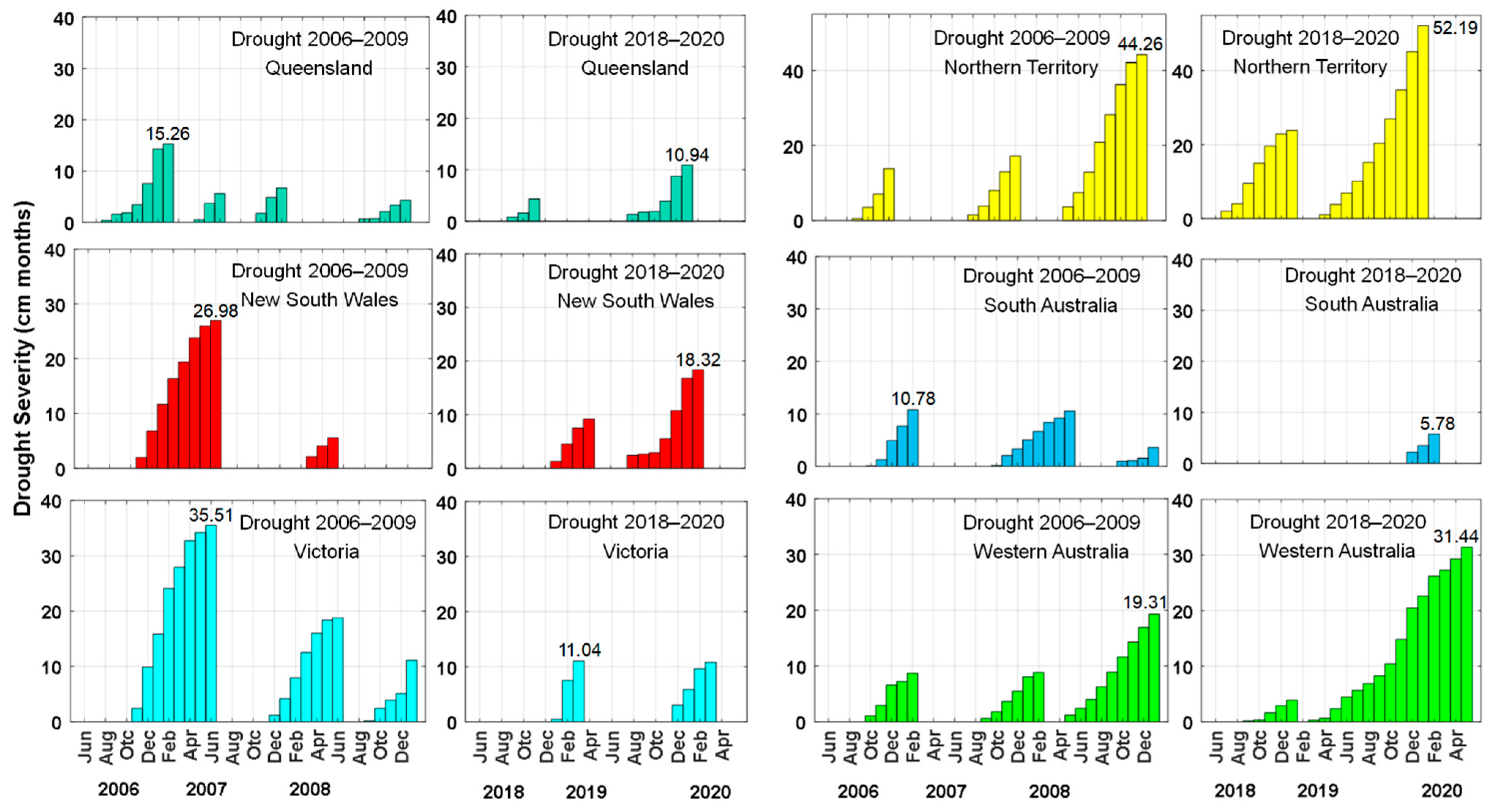


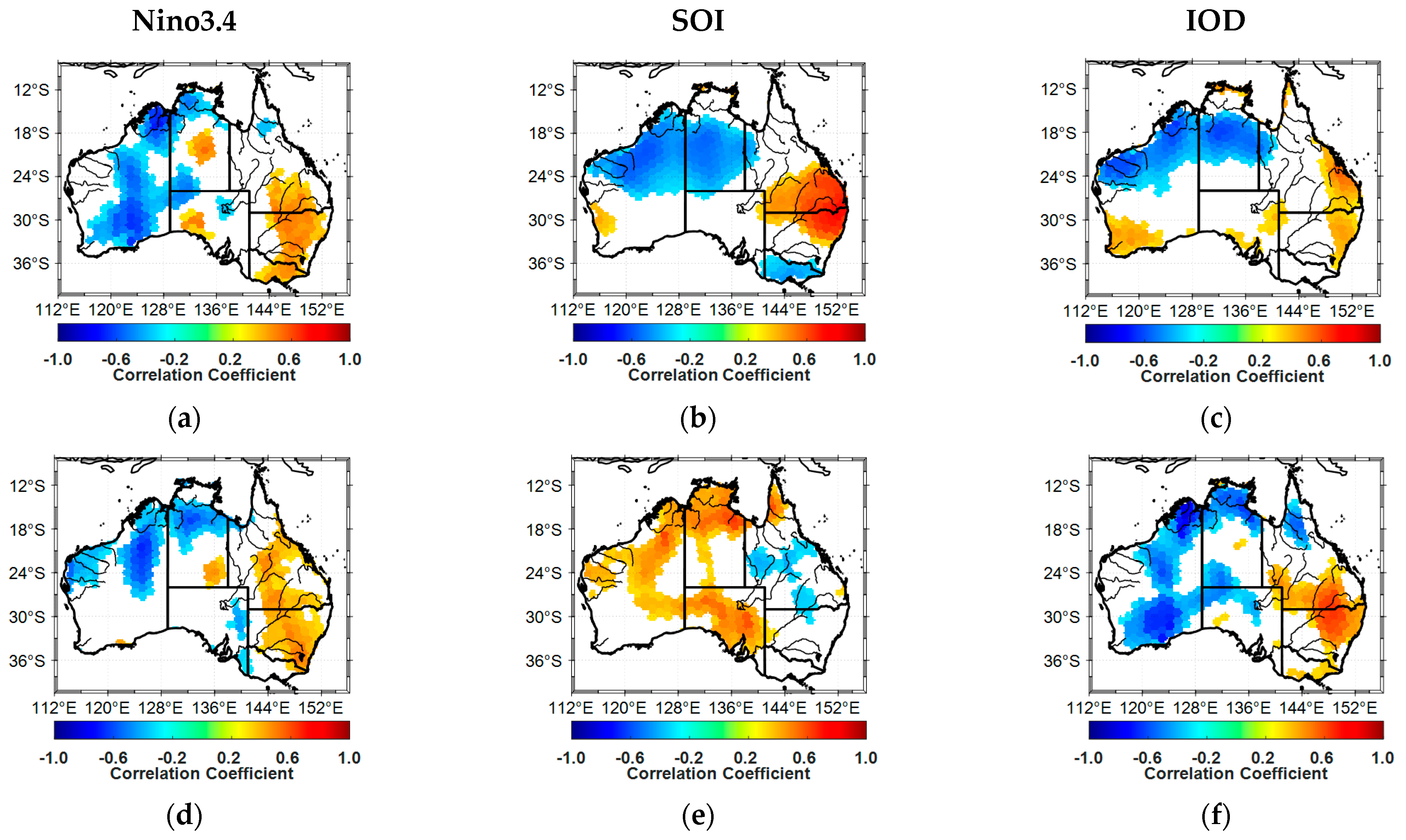
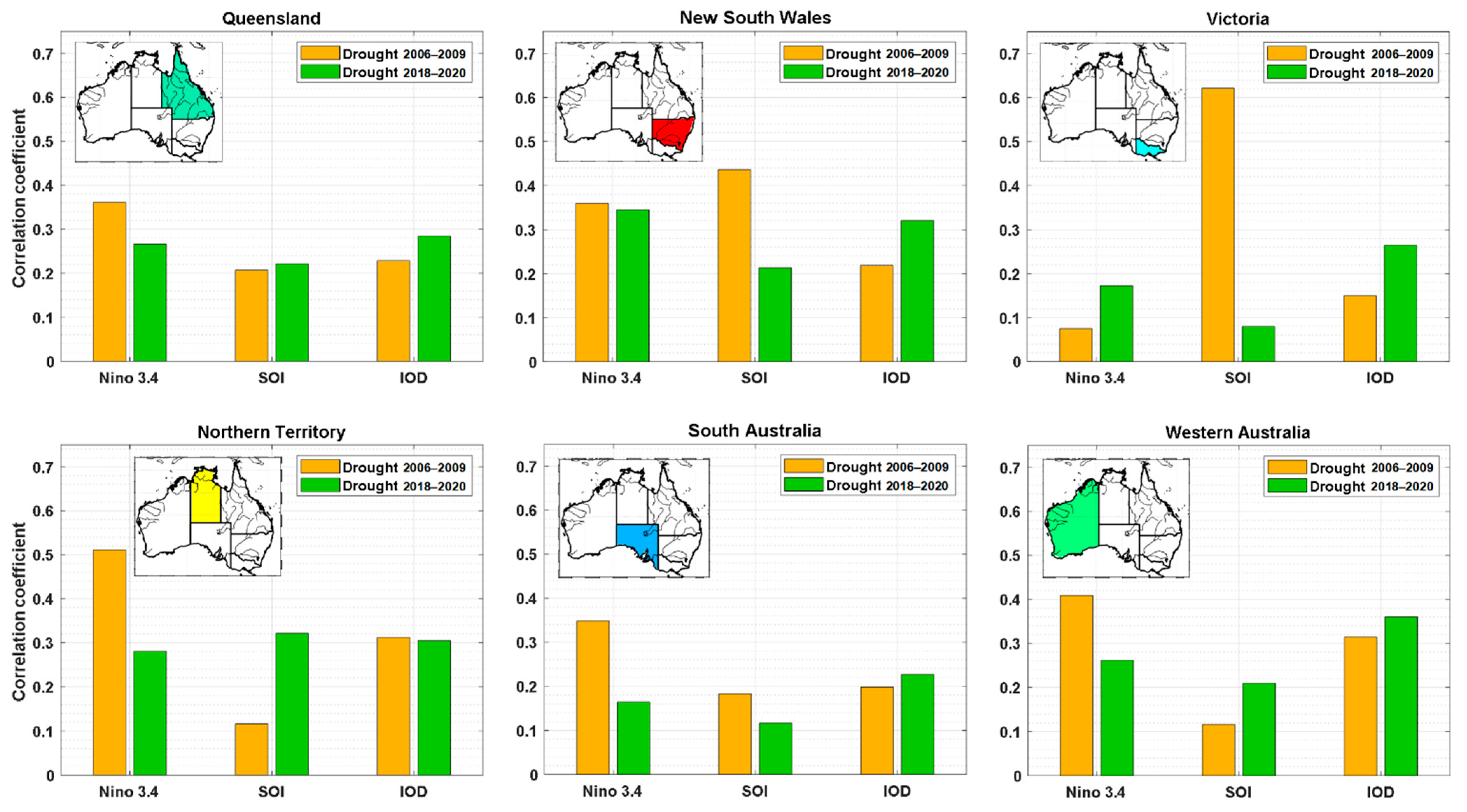

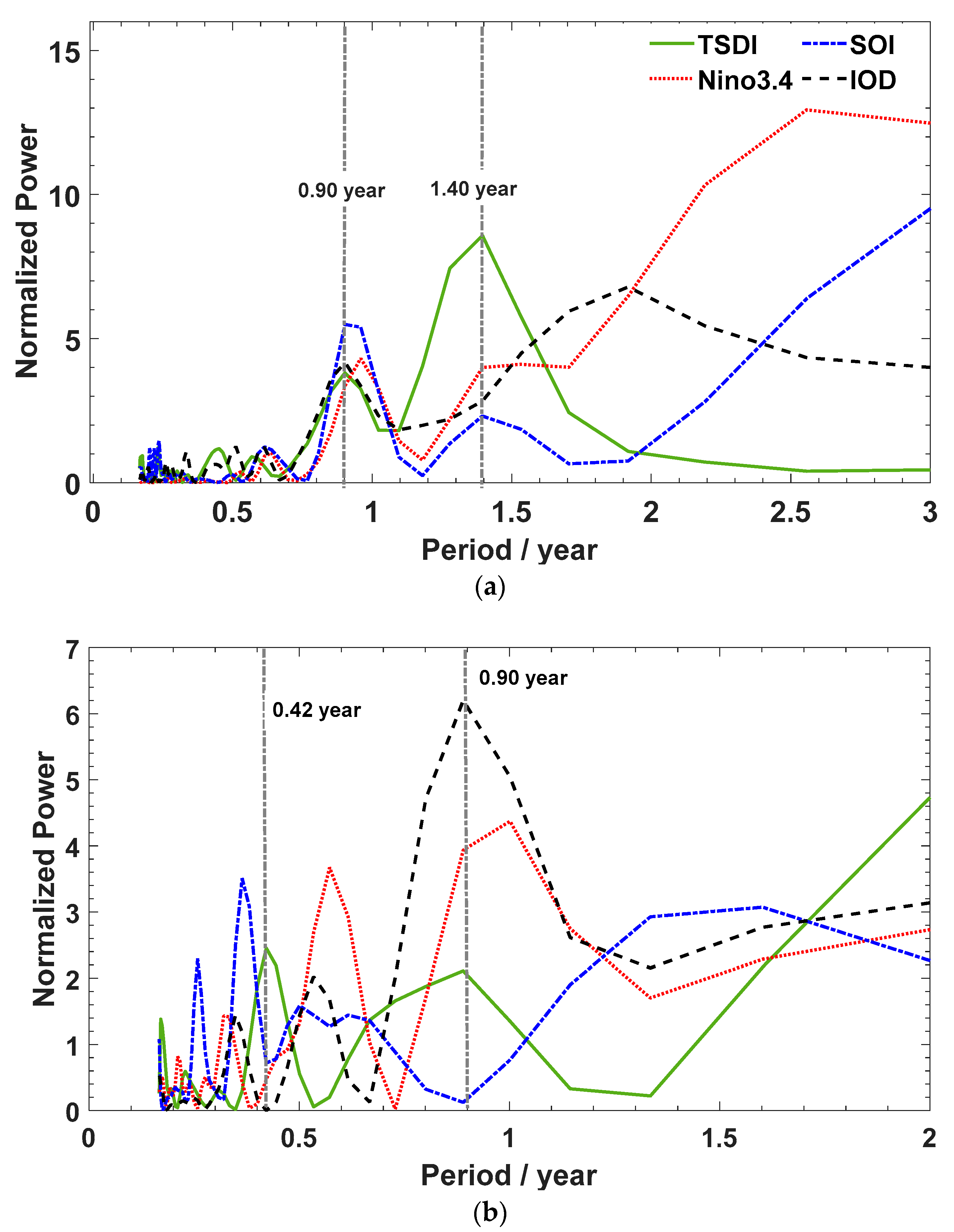
| Index | Detail | Source | Reference |
|---|---|---|---|
| Niño-3.4 | Average SSTs in the Niño-3.4 region (5° S–5° N, 170°–120° W) | https://psl.noaa.gov/gcos_wgsp/Timeseries/Nino34/, accessed on 22 February 2021 | [56] |
| SOI | Atmospheric index calculated using the pressure difference between Tahiti and Darwin | https://psl.noaa.gov/gcos_wgsp/Timeseries/SOI/, accessed on 22 February 2021 | [57,58,59] |
| IOD | Difference in SST anomalies between IOD W (10° S–10° N, 50°–70° E) and IOD E (10° S–10° N, 90°–110° E) | https://psl.noaa.gov/gcos_wgsp/Timeseries/DMI/, accessed on 22 February 2021 | [55] |
| Drought Grades | Mild | Moderate | Very | Extreme |
|---|---|---|---|---|
| TSDI | 0 to −0.79 | −0.80 to −1.29 | −1.30 to −1.59 | −1.60 and less |
| No. | Start Time | Ending Time | Last Time (Months) |
|---|---|---|---|
| 1 | April 2002 | August 2002 | 5 |
| 2 | October 2002 | January 2004 | 16 |
| 3 | October 2004 | March 2006 | 18 |
| 4 * | June 2006 | January 2009 | 32 |
| 5 | March 2009 | May 2010 | 15 |
| 6 | June 2015 | September 2015 | 4 |
| 7 | January 2016 | June 2016 | 6 |
| 8 * | June 2018 | May 2020 | 24 |
| Drought Period | Region | Queensland | New South Wales | Victoria | Northern Territory | South Australia | Western Australia |
|---|---|---|---|---|---|---|---|
| Drought 2006–2009 | Maximum Severity | 15.26 | 26.98 | 35.51 | 44.26 | 10.78 | 19.31 |
| Time | January 2007 | June 2007 | June 2007 | December 2008 | February 2007 | January 2009 | |
| Season | Summer | Winter | Winter | Summer | Summer | Summer | |
| Drought 2018–2020 | Maximum Severity | 10.94 | 18.32 | 11.04 | 52.19 | 5.78 | 31.44 |
| Time | January 2020 | February 2020 | March 2019 | January 2020 | February 2020 | May 2020 | |
| Season | Summer | Summer | Autumn | Summer | Summer | Autumn |
| Nino3.4 | SOI | IOD | |
|---|---|---|---|
| Drought 2006–2009 | 0.39/4 | 0.30/0 | 0.27/5 |
| Drought 2018–2020 | 0.26/3 | 0.27/1 | 0.31/6 |
| Region | RMS (cm) |
|---|---|
| Queensland | 1.35 |
| New South Wales | 1.21 |
| Victoria | 1.15 |
| Northern Territory | 2.11 |
| South Australia | 0.73 |
| Western Australia | 0.98 |
Publisher’s Note: MDPI stays neutral with regard to jurisdictional claims in published maps and institutional affiliations. |
© 2021 by the authors. Licensee MDPI, Basel, Switzerland. This article is an open access article distributed under the terms and conditions of the Creative Commons Attribution (CC BY) license (https://creativecommons.org/licenses/by/4.0/).
Share and Cite
Wang, W.; Shen, Y.; Wang, F.; Li, W. Two Severe Prolonged Hydrological Droughts Analysis over Mainland Australia Using GRACE Satellite Data. Remote Sens. 2021, 13, 1432. https://doi.org/10.3390/rs13081432
Wang W, Shen Y, Wang F, Li W. Two Severe Prolonged Hydrological Droughts Analysis over Mainland Australia Using GRACE Satellite Data. Remote Sensing. 2021; 13(8):1432. https://doi.org/10.3390/rs13081432
Chicago/Turabian StyleWang, Wei, Yunzhong Shen, Fengwei Wang, and Weiwei Li. 2021. "Two Severe Prolonged Hydrological Droughts Analysis over Mainland Australia Using GRACE Satellite Data" Remote Sensing 13, no. 8: 1432. https://doi.org/10.3390/rs13081432







